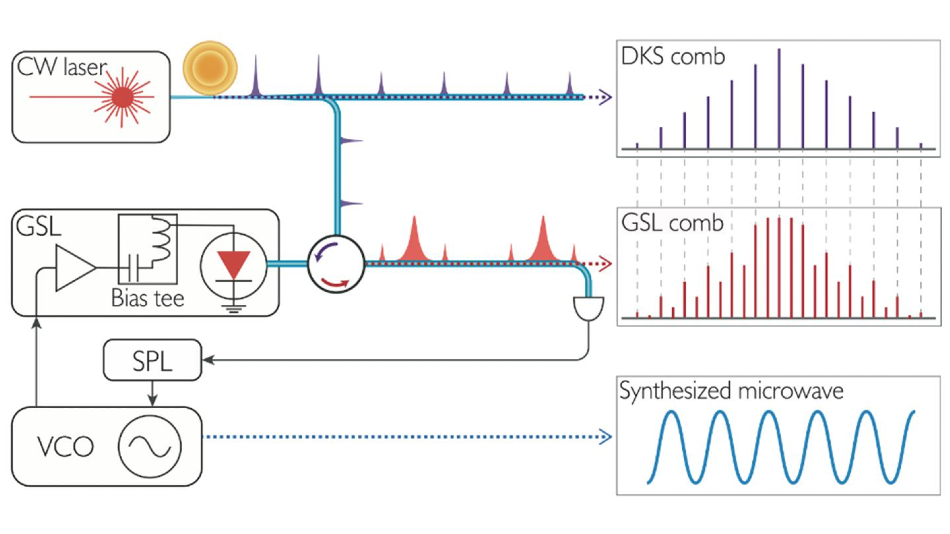Oct 5 2020
In various applications like ultrafast data processing and high-speed telecommunication, low-noise microwave signals play a highly crucial role.
 Injected by a microresonator frequency comb, a high-speed-modulated semiconductor laser can simultaneously generate low-noise microwaves and frequency combs with variable frequency gaps. Image Credit: W. Wenle (EPFL).
Injected by a microresonator frequency comb, a high-speed-modulated semiconductor laser can simultaneously generate low-noise microwaves and frequency combs with variable frequency gaps. Image Credit: W. Wenle (EPFL).
Typically, such signals are produced by using delicate and bulky microwave oscillators that are not appropriate for outdoor applications. However, physicists have recently been looking for a potential substitute: generation of high-quality microwaves with optical microresonator frequency combs.
Optical microresonators rely on the spectral purity and high optical frequency of laser fields to compactly and efficiently produce low-noise microwaves.
However, in general, a microresonator has the ability to produce only microwaves with very limited tunability of frequency. This is because the microwave frequency relies on the size of the resonator, which by itself is not so tunable.
At Tobias Kippenberg’s lab at EPFL, Trinity College Dublin (TCD), and Dublin City University (DCU), researchers recently devised an innovative method to produce variable low-noise microwaves by using a single optical microresonator. They have reported the study findings in the Science Advances journal.
The technique involves injecting a microresonator frequency comb into a compact laser, the intensity of which is regulated with the help of an off-the-shelf microwave oscillator.
The researchers forced the modulation frequency to strictly follow a subharmonic frequency of the microwave generated by the microresonator frequency comb, thereby successfully producing new microwaves with frequencies that can be considerably varied.
Moreover, the newly produced microwaves exhibit considerably lower phase-noise levels compared to those of off-the-shelf microwave oscillators and a microresonator frequency comb oscillator. Named frequency division, this mechanism helps transfer the purity of frequency of an optical signal into the microwave domain.
The new method allows the transfer of spectral purity between various microwave signals.
Traditionally, executing perfect microwave frequency division in a variable fashion has not been easy. Thanks to the fast-modulated semiconductor laser developed by our colleagues at TCD and DCU, now we can achieve this using a low-cost photodetector and a moderate control system.
Dr Wenle Weng, EPFL
The study was led by Dr. Weng. Moreover, the semiconductor laser produces a secondary frequency comb with highly densified spectral emissions that could be beneficial in a range of spectroscopic applications.
The semiconductor laser and the microresonator, which are the key components in the configuration of the proof-of-principle experiment, are separate and linked with lengthy fibers. At present, the researchers are striving to integrate and advanced-pack the device.
The newly developed variable microwave oscillator and frequency comb generator can be miniaturized and mass-produced. Thus, it could revolutionize the present-day surging market for sources of portable low-noise microwave and frequency comb.
Funding
This study was financially supported by the Swiss National Science Foundation, the Defense Advanced Research Projects Agency, the Defense Sciences Office (US), Science Foundation Ireland (SFI), and SFI/European Regional Development Fund.
Journal Reference:
Weng, W., et al. (2020) Frequency division using a soliton-injected semiconductor gain-switched frequency comb. Science Advances. doi.org/10.1126/sciadv.aba2807.